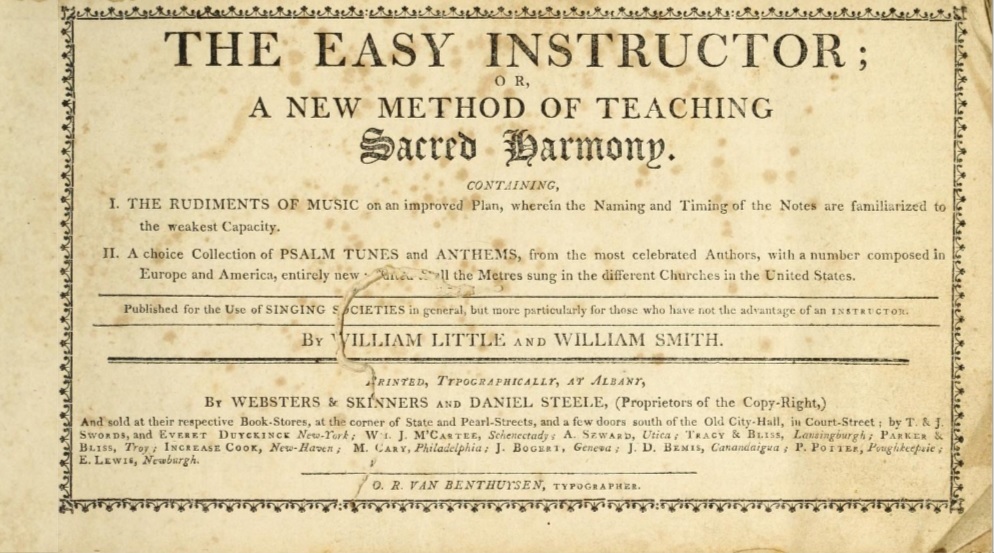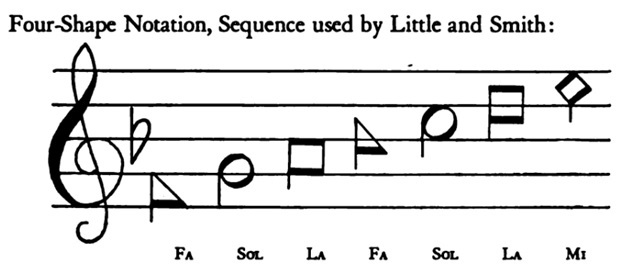


The Easy Instructor; Or, A New Method of Teaching Sacred Harmony, Containing, I. THE RUDIMENTS OF MUSIC on an Improved Plan, wherein the Naming and Timing of the Notes are familiarized to the weakest Capacity, II. A choice Collection of PSALM TUNES and ANTHEMS, from the most celebrated Authors, with a number composed In Europe and America, entirely new; Suited to all the Metres sung in the different Churches in the United States was compiled by William Little and William Smith. The front of the book has an "advertisement" section dated August 15, 1798, but it is believed that the book itself did not go to print until 1801.
On the Advertisement page of their book, Little and Smith acknowledge that this book may have the appearance of being a novelty. They state that if should this be true, then their book is "in danger of meeting with an unfavorable reception." They introduce the idea of using "characters" to show at sight the names of the four singing syllables. The authors felt that it would be easier to teach music with this method than it would be with lines and spaces. In this method of teaching music, Little and Smith used a right-angle triangle for "Fa," a circle for "Sol," a square for "La," and a diamond for "Mi."
Little and Smith may have been the first to publish shape-note music with these particular shapes, but they were not the originators of this system using these four shapes. This particular shape-note system was the invention of Philadelphia shopkeeper John Connelley. Connelley gave Little and Smith permission to use this system in their book, and Little and Smith did insert in their book that "The Music Types used in the printing this "Book" are secured to the Proprietors by Patent Right." Connelley also had business dealings with two other individuals who had compiled four-shape-note tune books: Andrew Adgate and Andrew Law. Adgate published The Philadelphia Harmony in 1790; Adgate's book had all round notes and there was a line at different angles going through the note to represent "Fa," "La," and "Mi." Law published The Art of Singing in 1803. Law used the same four shapes that Little and Smith used, except he reversed the "Fa" and "La" shapes.

We will never know exactly whose shape-note system came first and whose was copied. What we do know is that Little and Smith's system was accepted for use and survives unto this day. In 1810, John Wyeth of Harrisburg, Pennsylvania, published a tune book using Little and Smith's shape-note system. Wyeth's tune book was titled Wyeth's Repository of Sacred Music. Other tune books would follow.
Little and Smith's shape-note system has survived for well over 200 years, even though their tune book faded into history. Other four-syllable shape-note systems also faded into history. Almost 50 years after The Easy Instructor was first published, Little and Smith's shape-note system was the foundation for the seven-shape systems that would later follow.
Sources:
Britton, Allen P. "The Original Shape-Note Tune Books." Studies in the History of American Education, Ed. Claude Eggertsen,.(Ann Arbor: School of Education, University of Michigan, 1947).
Hatchett, Marion J. A Companion to 'The New Harp of Columbia,' (Knoxville: The University of Tennessee Press, 2005).
Little, William, and William Smith. The Easy Instructor; Or, A New Method of Teaching Sacred Harmony, Containing, 1. The Rudiments of Music on an Improved Plan, Wherein the Naming And Timing of the Notes Are Familiarized To the Weakest Capacity, 2. A Choice Collection Of PSALM TUNES And ANTHEMS, From The Most Celebrated Authors, With A Number Composed In Europe And America, Entirely New; Suited To All The Metres Sung In The Different Churches In The United States, (Albany: Printed for Websters & Skinners and Daniel Steele, 1801).
McLemore, B. F. Tracing the Roots of Southern Gospel Singers (Jasper, TX: B. F. (Bob) McLemore, 2005).